Ncert Solution of Redox Reactions: The most of the reactions taking place in the universe are the examples of Redox Reactions. This chapter help us to understand the activities happening inside and outside of the surroundings. We must learn this chapter properly so that we can solve the problems going to stand before us in future. This is the 7th chapter of chemistry for class 11th. This is very important and interesting chapter. All the topics of this chapter are helpful for study of other chapters of chemistry.
Ncert Solution of Redox Reactions: Objectives
Chemistry deals with the study of composition, structure and properties of varieties of matter and the change of one kind of matter into another. This change occurs through a number of different types of reactions. One important type of such reactions are reduction- oxidation or simply Redox Reactions. The objectives of this chapter are followings: Ncert Solution of Redox Reactions
- To identify redox reactions as a class of reactions in which oxidation and reduction reactions occur simultaneously.
- To define the terms oxidation, reduction, oxidant and reductant.
- To explain mechanism of Redox reactions by electron transfer and oxidation number concept.
- To use the concept of oxidation number to identify oxidant and reductant in a reaction.
- To classify Redox reactions into combination, decomposition, displacement and disproportionation reactions.
- To suggest a comparative order among various reductants and oxidants.
- To balance chemical equations using oxidation number and half reaction methods.
- To learn the concept of Redox reactions in terms of electrode processes. Ncert Solution of Redox Reactions
Ncert Solution of Redox Reactions: Class 11 Free Pdf Download
Questions and answers of Ncert Solution of Redox Reactions:
Question 1. Assign oxidation number to the underlined elements in each of the following species: 
Answer: (a) In NaH2PO4 , The oxidation number of Na = +1, H = +1, O = –2 and P = ? Let the oxidation number of P = x then from oxidation number rules: (+1) + 2(+1) + x + 4(–2) = 0 ∴ x = +5 and oxidation number of P = +5.
(b) In NaHSO4, The oxidation number of Na = +1, H = +1, O = –2 and S = ? Let the oxidation number of S = x then from oxidation number rules: (+1) + (+1) + x + 4(–2) = 0 ∴ x = +6 and oxidation number of S = +6.
(c) In H4P2O7 , The oxidation number of H = +1, O = –2 and P = ? Let the oxidation number of P = x then from oxidation number rules: 4(+1) + 2x + 7(–2) = 0 ∴ x = +5 and oxidation number of P = +5.
(d) In K2MnO4 , The oxidation number of K = +1, O = –2 and Mn = ? Let the oxidation number of Mn = x then from oxidation number rules: 2(+1) + x + 4(–2) = 0 ∴ x = +6 and oxidation number of Mn = +6.
(e) In CaO2, The oxidation number of Ca = +2, and O = ? Let the oxidation number of Ca = x then from oxidation number rules: 2(+1) + 2 x = 0 ∴ x = –1 and oxidation number of O = –1.
(f) In NaBH4, The oxidation number of Na = +1, H = –1, and B = ? Let the oxidation number of B = x then from oxidation number rules: (+1) + x + 4(–1) = 0 ∴ x = +3 and oxidation number of B = +3.
(g) In H2S2O7, The oxidation number of H = +1, O = –2 and S = ? Let the oxidation number of S = x then from oxidation number rules: 2(+1) + 2x + 7(–2) = 0 ∴ x = +6 and oxidation number of S = +6.
(h) In KAl(SO4)2.12H2O, The oxidation number of K = +1, Al = +3, H = +1, O = –2 and S = ? Let the oxidation number of S = x then from oxidation number rules: (+1) + (+3) + 2x + 8(–2) + 24(+1) + 12(–2) = 0 ∴ x = +6 and oxidation number of S = +6.
Question 2. What are the oxidation number of the underlined elements in each of the following and how do you rationalise your results ? ![]()
Answer: (a) In KI3, since the oxidation number of K is +1, therefore, the average oxidation number of iodine = 1/3. But the oxidation number cannot be fractional. Therefore we must consider its structure. K+ [I — I ← I]–. Here, a coordinate bond is formed between I2 molecule and I– ion. The oxidation number of two iodine atoms forming the I2 molecule is zero while that of iodine forming the coordinate bond is –1. Thus, the oxidation number of three iodine atoms in KI3 are 0, 0 and –1 respectively.
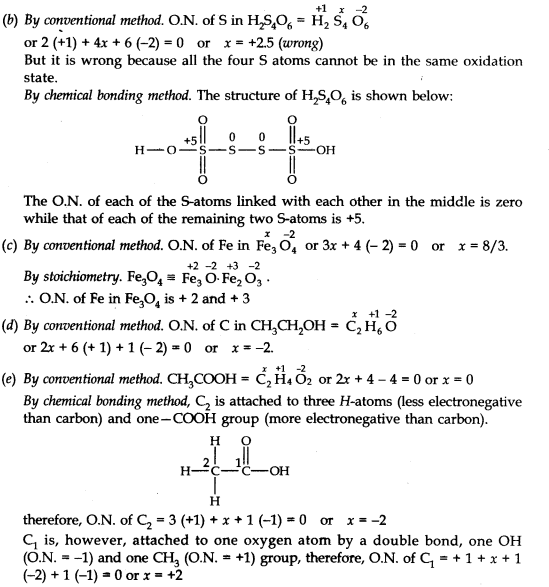
Question 3. Justify that the following reactions are redox reactions:
(a) CuO(s) + H2(g) → Cu(s) + H20(g)
(b) Fe2O3(s) +3CO(g) → 2Fe(s) + 3CO2(g)
(c) 4BCl3(g) +3LiAlH4(s) → 2B2H6(g) + 3LiCl(s) + 3AlCl3(s)
(d) 2K(s) +F2(g) → 2K+F–(s)
(e) 4NH3(g) + 5O2 (g) → 4NO(g) + 6H2O (g) (Ncert Solution of Redox Reactions)
Answer:
![]()
Here O is removed from CuO, therefore, it is reduced to Cu and O is added to H2 to form H2O, therefore, it is oxidised. Further O.N. of Cu decreases from +2 in CuO to 0 in Cu while that of H increases from 0 in H2 to +1 in H2O. Therefore, CuO is reduced to Cu and H2 is oxidised to H2O. Thus, this is a redox reaction.

Here, O.N. of Fe decreases from +3 in Fe2O3 to 0 in Fe while that of C increases from +2 in CO to +4 in CO2. Further, oxygen is removed from Fe2O3 and added to CO. Therefore, Fe2O3 is reduced while CO is oxidised. Thus, this is a redox reaction.

Here, O.N. of B decreases from +3 in BCl3 to –3 in B2H6 while that of H increases from –1 in LiAlH4 to +1 in B2H6. Therefore, BCl3 is reduced while LiAlH4 is oxidised. Further, H is added to BCl3 but is removed from LiAlH4, therefore, BCl3 is reduced while LiAlH4 is oxidised. Thus it is a redox reaction.
(d) 2 K (s) + F2 (g) → 2 K+F– (s)
Here, each K atom has lost one electron to form K+ ion while F2 has gained two electrons to form two I– ions. Therefore, K is oxidised while F2 is reduced. Thus it is a redox reaction.
e) 4NH3(g) + 5O2 (g) → 4NO(g) + 6H2O (g)
Here, O.N. of N increases from –3 in NH3 to +2 in NO while that O decreases from 0 in O2 to –2 in NO or H2O. Therefore, NH3 is oxidised while O2 is reduced. Further, H has been removed from NH3 and added to O2. Therefore, NH3 has been oxidised while O2 is reduced. Thus, this is a redox reaction.
Question 4. Fluorine reacts with ice and results in the change:
H20(S) + F2 (g) → HF(g) + HOF(g)
Justify that this reaction is a redox reaction.
Answer: Writing the O.N. of each atom above its symbol, we have, ![]()
Here, O.N. of F decreases from 0 in F2 to –1 in HF and increases from 0 to +1 in HOF. Therefore, F2 is both oxidised and reduced. Thus, it is a redox reaction and particularly a disproportionation reaction.
Question 5. Calculate the oxidation number of sulphur, chromium and nitrogen in H2SO5, CrO5 and NO3–. Suggest structure of these compounds. Count for the fallacy. (Ncert Solution of Redox Reactions)
Answer:

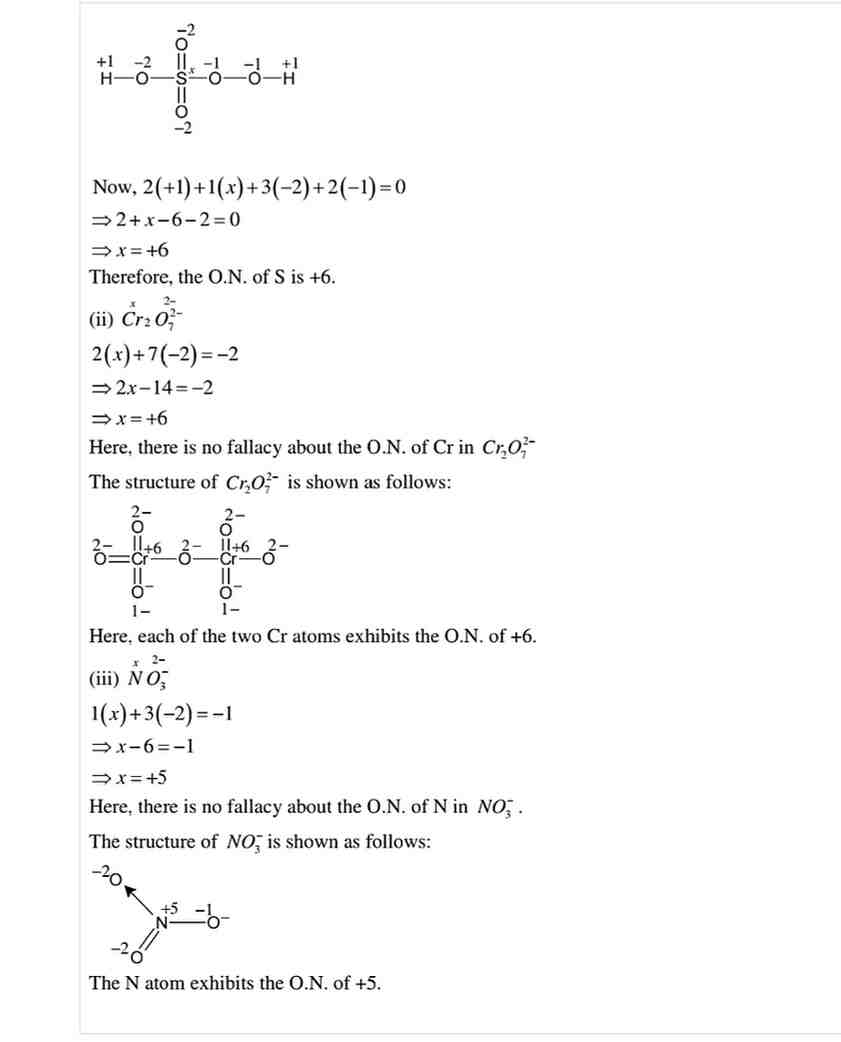
Question 6.Write formulas for the following compounds:
(a) Mercury (II) chloride, (b) Nickel (II) sulphate, (c) Tin (IV) oxide, (d) Thallium (I) sulphate, (e) Iron (III) sulphate, (f) Chromium (III) oxide.
Answer: (a) Hg(II)Cl2, (b) Ni(II)SO4, (c)Sn(IV)O2 (d) T12(I)SO4, (e) Fe2(III)(S04)3, (f) Cr2(III)O3.
Question 7. Suggest a list of substances where carbon can exhibit oxidation states from -4 to +4 and nitrogen from -3 to +5. (Ncert Solution of Redox Reactions)
Answer: The substances where carbon can exhibit oxidation states from –4 to +4 are shown in the following table: 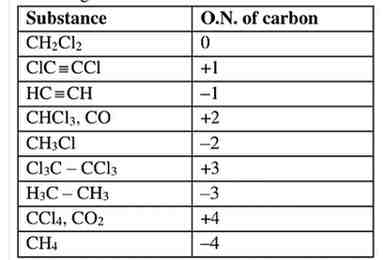
The substances where nitrogen can exhibit oxidation states from –3 to +5 are shown in the following table: 
Question 8. While sulphur dioxide and hydrogen peroxide can act as an oxidising as well as reducing agents in their reactions, ozone and nitric acid act only as oxidants. Why? (Ncert Solution of Redox Reactions)
Answer: (l) In SO3, O.N. of S is +4. In principle, S can have a minimum O.N. of –2 and maximum of +6. Therefore, S in SO3 can either increase or decrease its O.N., and hence, SO3 can act both as oxidising and reducing agent.
(ll) In H2O2, O.N. of O is –1. In principle, O can have a minimum O.N. of –2 and maximum of zero. Therefore, O in H2O2 can either increase or decrease its O.N., and hence H2O2 can act both as oxidising and reducing agent.
(lll) In O3, the O.N. of O is zero. It can only decrease its O.N. from zero to –1 or –2. Therefore O3 acts only as oxidising agent.
(lv) In HNO3, The O.N. of N is +5 that is maximum. Therefore, it can only decrease its O.N. and hence, it acts as oxidising agent.
Question 9. Consider the reactions:
(a) 6CO2(g) 6H2O(l) ———> C6H12O6(s) + 6O6(g) (b) O3(g) + H2O2(l) H2O(l) + 2O2(g)
Why it is more appropriate to write these reactions as:
(a) 6CO2(g) + 12H2O(l) → C6H12O6(s) + 6H2O(l) + 6O2(g)
(b) O3(g) + H2O2 (l) → H2O(l) + O2(g) + O2(g)
Also suggest a technique to investigate the path of above (a) and (b) redox reactions. (Ncert Solution of Redox Reactions)
Ans:- (a) The process of photosynthesis actually occurs in two steps. In the first step, H2O decomposes to give H2 and O2 in presence of chlorophyll and the H2 thus formed reduces CO2 into C6H12O6 in the second step. During the second step some H2O molecules are also produced as given below:—- 
Therefore, it is more appropriate to write the equation as (lll) because the above reaction justifies that 12 molecules of H2O are used for per molecule of carbohydrate formation and 6H2O are produced during the process.
(b) The purpose of writing O2 two times suggests that O2 is being obtained from each of the two reactants. The reactions can be represented as 
The path of reaction (a) and (b) can be determined by using H2O18 or D2O in reaction (a) or by using H2O218 or O318 in reaction (b).
Question 10. The compound AgF2 is unstable. However, if formed, the compound acts as a very strong oxidising agent. Why?
Answer: In AgF2, oxidation state of Ag is +2 which is very unstable. Therefore it quickly accepts an electron to form the most stable +1 oxidation state. The reaction is Ag2+ + e– → Ag+ Therefore, AgF2, if formed, will acts as strong oxidising agent.
Question 11. Whenever a reaction between an oxidising agent and a reducing agent is carried out, a compound of lower oxidation state is formed if the reducing agent is in excess and a compound of higher oxidation state is formed if oxidising agent is in excess. Justify this statement giving three illustrations. (Ncert Solution of Redox Reactions)
Answer: (l) C is a reducing agent and O2 is an oxidising agent. If excess of carbon is burnt in a limited supply of O2, CO is formed in which the oxidation state of C is +2. If excess of O2 is used, the initially formed CO gets oxidised to CO2 in which oxidation state of C is +4. 
(ll) P4 is a reducing agent and Cl2 is an oxidising agent. If excess of Phosphorous is used in a limited supply of Cl2, PCl3 is formed in which the oxidation state of P is +3. If excess of Cl2 is used, the initially formed PCl3 gets oxidised to PCl5 in which oxidation state of P is +5. 
(lll) Na is a reducing agent while O2 is an oxidising agent. If excess of Na is used, sodium oxide is formed in which the oxidation state of O is –2. If excess of O2 is used, Na2O2 is formed in which the oxidation state of O is –1 which is higher than –2. ![]()
Question 12. How do you account for the following observations?
(a) Though alkaline potassium permanganate and acidic potassium permanganate both are used as oxidants, yet in the manufacture of benzoic acid from toluene we use alcoholic potassium permanganate as an oxidant. Why? Write a balanced redox equation for the reaction.
(b) When concentrated sulphuric acid is added to an inorganic mixture containing chloride, we get colourless pungent smelling gas HCl, but if the mixture contains bromide then we get red vapour of bromine. Why? (Ncert Solution of Redox Reactions)
Answer: (a) Benzene can be oxidised to benzoic acid in acidic, basic and neutral medium according to the following redox equations: 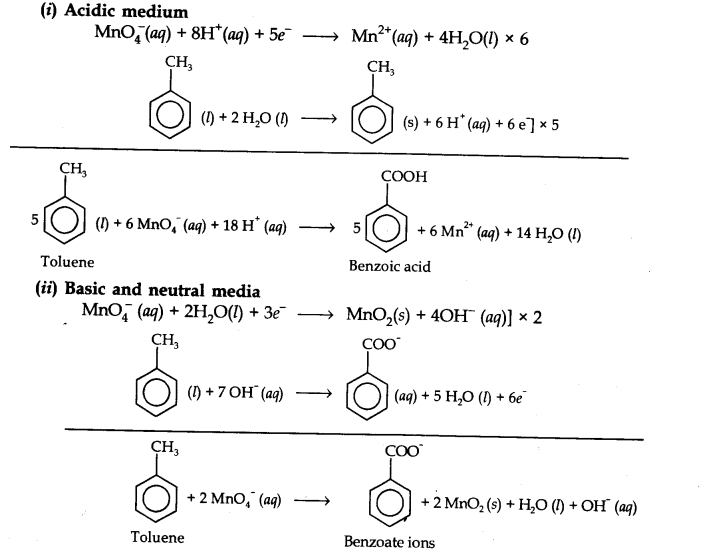
In the laboratory, benzoic acid is usually prepared by alkaline KMnO4 oxidation of toluene. However, in industry alcoholic KMnO4 is preferred because of the following reasons:
(l) The cost of addition of an acid or base is avoided because in the neutral medium, the base (OH–) are produced in the reaction itself. (ll) Since reactions occur faster in homogeneous medium than in heterogeneous medium, therefore alcohol helps in mixing the two reactants because both are polar.
(b) When conc. H2SO4 is added to an inorganic mixture containing chloride, a pungent smelling gas HCl is produced because a stronger acid displaces a weaker acid from its salt. 
Since HCl is a very weak reducing agent, it cannot reduce H2SO4 to SO2 and hence HCl is not oxidised to O2. However, when the mixture contains bromide ion, the initially produced HBr being a stronger reducing agent than HCl reduces H2SO4 to SO2 and is itself oxidised to produce red vapour of Br2. 
Question 13. Identify the substance oxidised, reduced, oxidising agent and reducing agent for each of the following reactions. (Ncert Solution of Redox Reactions)
Answer: 
Question 14. Consider the reactions: 
Why does the same reductant, thiosulphate react differently with iodine and bromine? (Ncert Solution of Redox Reactions)
Answer: The average O.N. of S in S2O32– is +2 and in S4O62- is 2.5. The O.N. of S in SO42- is +6. Since Br2 is a stronger oxidising agent than I2. It oxidises S of S2O32– to a higher oxidation state of +6 and hence forms SO42- ion.I2 , however, being a weaker oxidising agent oxidises S of S2O32– ion to a lower oxidation of +2.5 in S4O62- ion. It is because of this reason that thiosulphate reacts differently with Br2 and I2 .
Question 15. Justify-giving reactions that among halogens, fluorine is the best oxidant and among hydrohalic compounds, hydroiodic add is the best reductant. (Ncert Solution of Redox Reactions)
Answer: Halogens have a strong tendency to accept electrons. Therefore, they are strong oxidising agents. Their relative oxidising power is, however, measured in terms of their electrode potentials. Since the electrode potentials of halogens decrease in the order: F2 (+2.87V) > Cl2 (+1.36V) > Br2 (+1.09V) > I2 (+0.54V), therefore, their oxidising power decreases in the same order.
This is evident from the observation that F2 oxidises Cl– to Cl2, Br–to Br2, I – to I2 ; Cl2 oxidises Br–to Br2 and F to I2 but not F– to F2. Br2, however, oxidises F to I2 but not F– to F2 , and Cl– to Cl2.
F2(g) + 2Cr(aq) ———–> 2F–(aq) + Cl2(g); F2(g) + 2Br–(aq) ———-> 2F–(aq) + Br2 (Z)
F2(g) + 2I–(aq) ———-> 2F–(aq) + I2(s); Cl2 (g) + 2Br–(aq) ————> 2Cl–(aq) + Br2 (Z)
Cl2(g) + 2I–(aq) ———–> 2Cl– (aq) + I2(s) and Br2 (Z) + 2F ———> 2Br– (aq) + I2(s)
Thus, F2 is the best oxidant.
Conversely, halide ions have a tendency to lose electrons and hence can act as reducing agents. Since the electrode potentials of halide ions decreases in the order: I–(-0.54 V) > Br– (-1.09 V) > Cl–(-1.36 V) > I2 (-2.87 V), therefore, the reducing power of the halide ions or their corresponding hydrohalic acids decreases in the same order: HI > HBr > HCl > HF. Thus, hydroiodic acid is the best reductant. This is supported by the following reactions. For example, HI and HBr reduce H2S04 to S02 while HCl and HF do not.
2HBr + H2S04 —–—> Br2+ S02 + 2H2O; 2HI + H2S04 ——> I2 + S02 + 2H2O
Further F reduces Cu2+ to Cu+ but Br does not.
2Cu2+(aq) + 4I–(aq) —–>Cu2I2(s) + I2(aq); Cu2+(aq) + 2Br–———–> No reaction.
Thus, HI is a stronger reductant than HBr.
Further among HCl and HF, HCl is a stronger reducing agent than HF because HCl reduces MnO2 to Mn2+ but HF does not.
MnO2 (s) + 4HCl(aq) ——-> MnCl2(aq) + Cl2(aq) + 2H2O
MnO2 (s) + 4HF(l) ———–> No reaction.
Thus, the reducing character of hydrohalic acids decreases in the order: HI > HBr > HCl > HF.
Question 16. Why does the following reaction occur? 
Answer: 
Question 17. Consider the reactions:
(a) H3P02(aq) + 4AgNO3(aq) + 2H2O(l) → H3PO4(aq) + 4Ag(s) + 4HNO3(aq)
(b) H3P02(aq) + 2CuS04(aq) + 2H2O(l) → H3P04(aq) + 2Cu(s) + H2S04(aq)
(c) C6H5CHO(l) + 2[Ag(NH3)2]+(aq) + 30H–(aq) → C6H5COO–(aq) + 2Ag(s) + 4NH3(aq) + 2H20(l)
(d) C6H5CHO(l) + 2Cu2+(aq) + 5OH–(aq) → No change observed
What inference do you draw about the behaviour of Ag+ and Cu2+ from these reactions?
Answer: Reactions (a) and (b) indicates that H3PO2 is a reducing agent and thus reduces both AgNO3 and CuSO4 to Ag and Cu respectively. Conversely, both AgNO3 and CuSO4 act as oxidising agent and thus oxidise H3PO2 into H3PO4.
Reaction (c) suggests that [Ag(NH3)2]+ oxidises C6H5CHO into C6H5COO– but reaction (d) indicates that Cu2+ ions cannot oxidise C6H5CHO to C6H5COO–. Therefore, from the above reactions, we conclude that Ag+ is a stronger oxidising agent than than Cu2+ ion.
Question 18. Balance the following redox reactions by ion-electron method.
(a) MnO4–(aq) +I–(aq) → Mn02(s) + I2 (s) (in basic medium)
(b) MnO4–(aq) + S02(g) → Mn2+(aq) +H2S04–(in acidic solution)
(c) H2O2(aq) + Fe2+(aq) → Fe3+(aq) + H2O(l) (in acidic solution)
(d) Cr2O72- (aq) + S02 (g)→ Cr3+ (aq) + SO42-(aq) (in acidic solution)
Answer: 
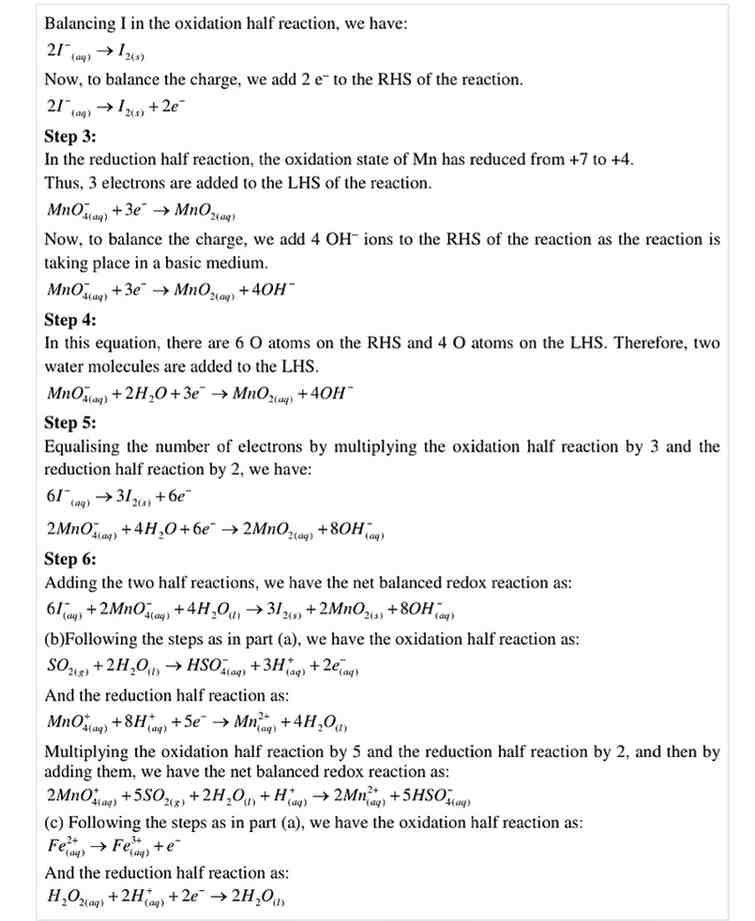
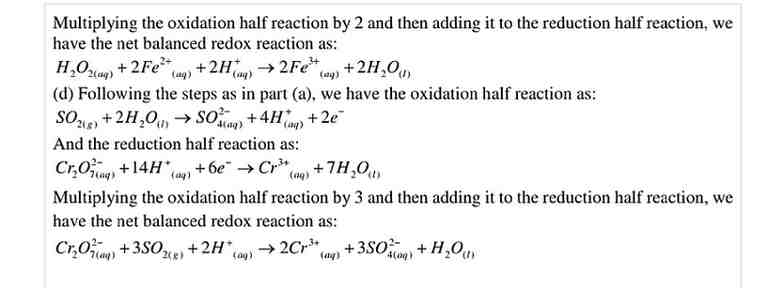
Question 19. Balance the following equation in basic medium by ion electron method and oxidation number method and identify the oxidising agent and the reducing agent.
(a) P4(s) + OH–(aq) → PH3(g) + H2PO2–(aq)
(b) N2H4(l) + ClO–(aq) → NO(g) + CV(aq)
(c) Cl2O7(g) + H2O2(aq) → ClO2–(aq) + O2(g) + H+
P4 acts both as an oxidising as well as a reducing agent. (Ncert Solution of Redox Reactions)
Answer: 

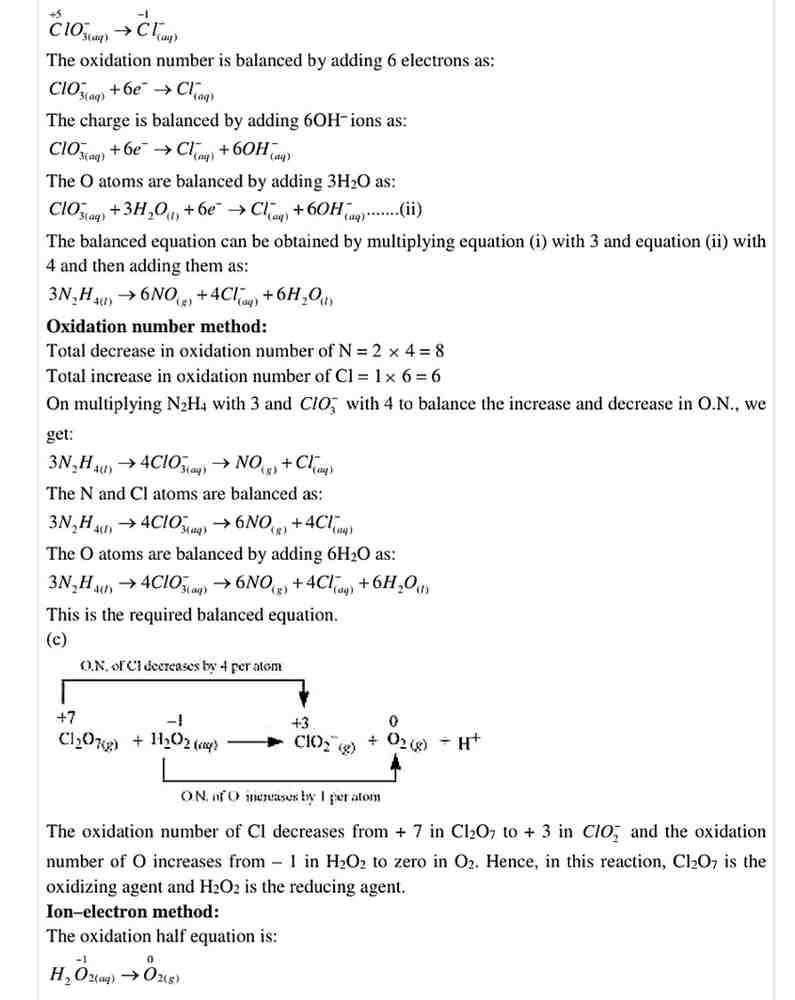
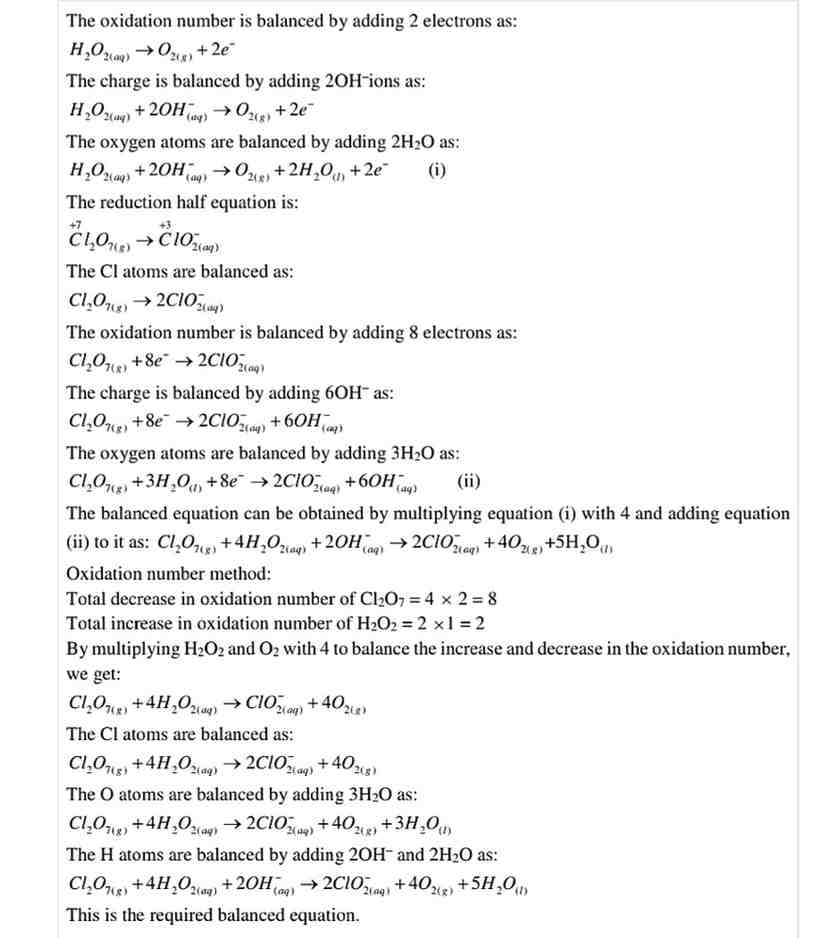
Question 20. Write your informations about the reaction:
(CN)2(g) + 2OH–(aq) → CN–(aq) + CNO–(aq) + H2O(l)
Answer : 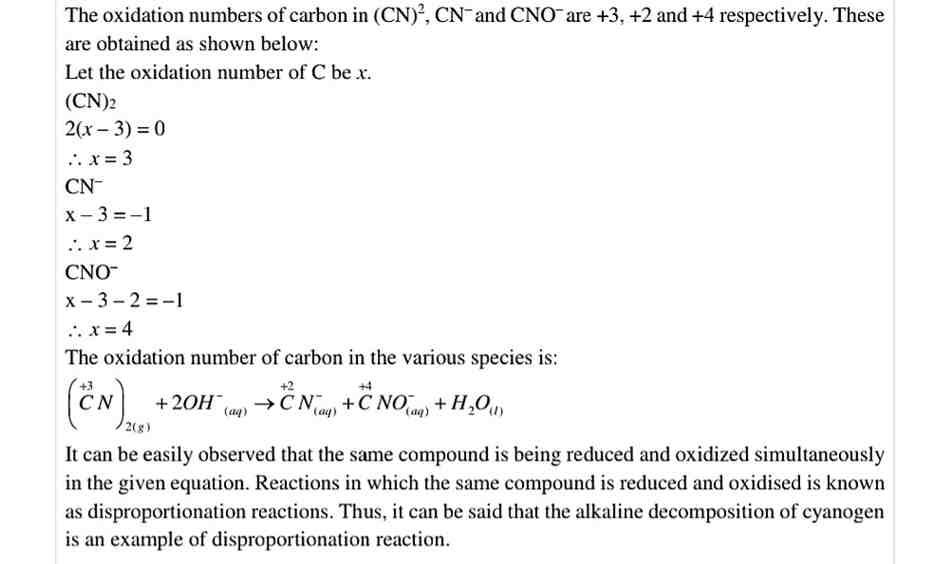
Question 21. The Mn3+ ion is unstable in solution and undergoes disproportionation to give Mn2+, MnO2 and H+ ion. Write a balanced ionic equation for the reaction. (Ncert Solution of Redox Reactions)
Answer: 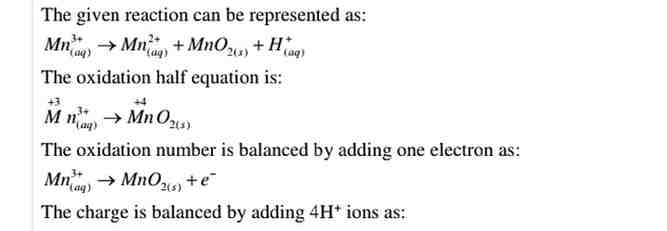
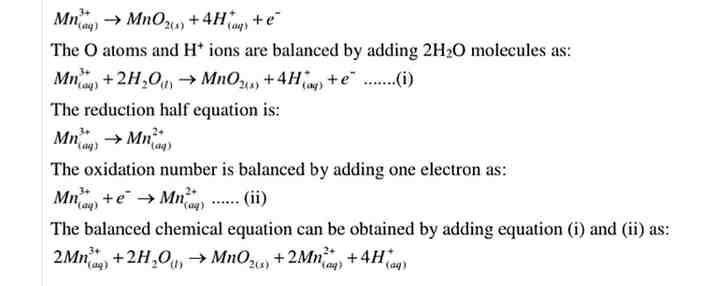
Question 22. Consider the elements: Cs, Ne, I, F
(a) Identify the element that exhibits -ve oxidation state.
(b) Identify the element that exhibits +ve oxidation state.
(c) Identify the element that exhibits both +ve and -ve oxidation states.
(d) Identify the element which neither exhibits -ve nor +ve oxidation state. (Ncert Solution of Redox Reactions)
Answer: (a) F, Fluorine being the most electronegative element exhibits –ve oxidation state of –1.
(b) Cs, An alkali metal has a single electron in the valence shell. It shows + oxidation state.
(c) Iodine (I) has seven electrons in its valence shell. It shows an oxidation state of –1 to +7 in its compounds.
(d) Neon(Ne) is an inert gas with high ionization enthalpy and zero electron affinity. Hence, it neither shows –ve nor positive oxidation state.
Question 23. Chlorine is used to purify drinking water. Excess of chlorine is harmful. The excess chlorine is removed by treating with sulphur dioxide. Present a balanced equation for the reaction for this redox change taking place in water.
Answer: The given reaction can be represented as: Cl2(g) + SO2(g) + H2O (l) → Cl–(aq) + SO42–(aq) The oxidation half reaction can be : 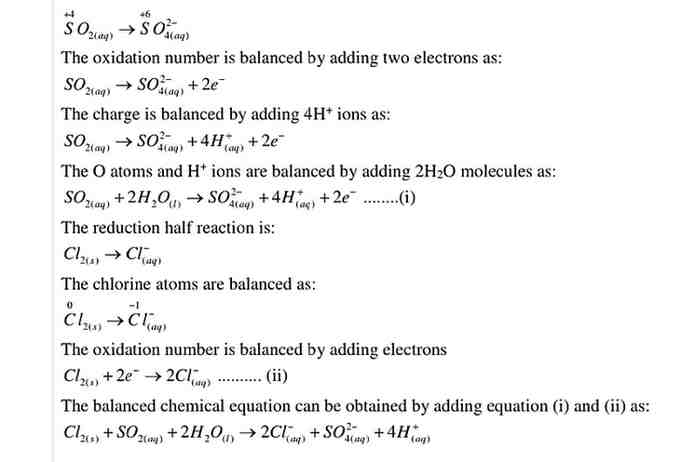
Question 24. Refer to the periodic table given in your book and now answer the following questions.
(a) Select the possible non-metals that can show disproportionation reaction.
(b) Select three metals that show disproportionation reaction.
Answer: In disproportionation reactions, one of the reacting substance must shows atleast three oxidation states. Hence (a) P, Cl and S can show disproportionation reactions as these elements can exist in three or more oxidation states. (b) Mn, Cu and Ga can show disproportionation reaction between they can exist in three or more oxidation states in their compounds.
Question 25. In Ostwald’s process for the manufacture of nitric add, the first step involves the oxidation of ammonia gas by oxygen gas to give nitric oxide gas and steam. What is the maximum wight of nitric oxide that can be obtained starting only with 10.0 g of ammonia and 20.0 g of oxygen? (Ncert Solution of Redox Reactions)
Answer: 
Question 26. Using the standard electrode potentials given in Table 8.1, predict if the reaction between the following is feasible:
(a) Fe3+(aq) and I-(aq) (b) Ag+ (aq) and Cu(s)
(c) Fe3+(aq) and Cu(s) (d)Ag(s) and Fe3+(aq)
(e) Br2 (aq) and Fe3+ (aq).
Answer: 
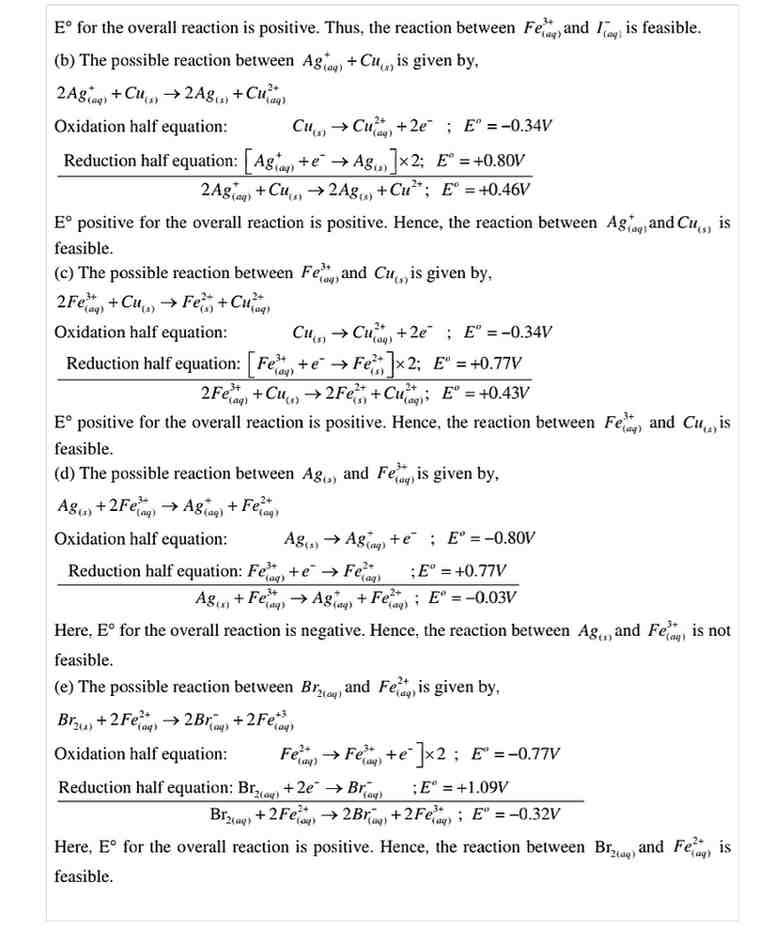
Question 27. Predict the products of electrolysis in each of the following:
(i) An aqueous solution of AgNO3 with silver electrodes.
(ii) An aqueous solution of silver nitrate with platinum electrodes.
(iii) A dilute solution of H2S04with platinum electrodes.
(iv) An aqueous solution of CuCl2 with platinum electrodes. (Ncert Solution of Redox Reactions)
Answer: 
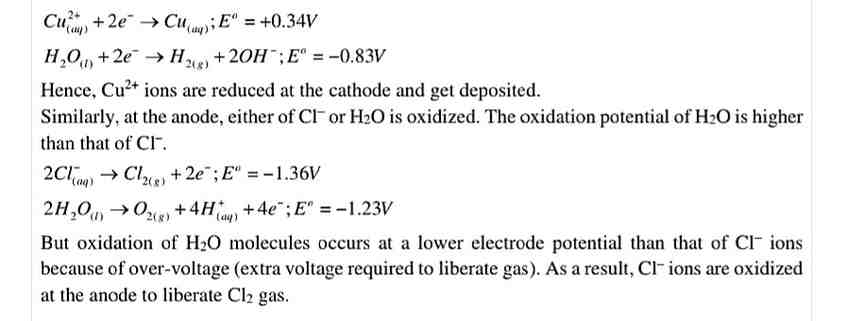
Question 28. Arrange the following metals in the order in which they displace each other from the solution of their salts. Al, Cu, Fe, Mg and Zn.
Answer: A metal of stronger reducing power displaces another metal of weaker reducing power from its salt solution. The order of the increasing reducing powers of the given metals is Cu < Fe < Zn < Al < Mg. Hence, we can say that Mg can displace Al from its salt solution. But Al cannot displace Mg. Thus, the order in which the given metals displace each other from the solution of their salts is Mg > Al > Zn > Fe > Cu.
Question 29. Given the standard electrode potentials,
K+/K = -2.93 V, Ag+/Ag = 0.80 V, Hg2+/Hg = 0.79 V, Mg2+/Mg = -2.37 V,
Cr3+/Cr = -0.74 V. Arrange these metals in increasing order of their reducing power. (Ncert Solution of Redox Reactions).
Answer: The lower the electrode potential, the stronger is the reducing is the reducing agent. Therefore, the increasing order of the reducing power of the given metals is Ag < Hg < Cr < Mg < K.
Question 30. Depict the galvanic cell in which the reaction, Zn(s) + 2Ag+(aq) → Zn2+(aq) + 2Ag(s)
takes place. Further show:
(i) which of the electrode is negatively charged.
(ii) the carriers of current in the cell and
(iii) individual reaction at each electrode.
Answer: 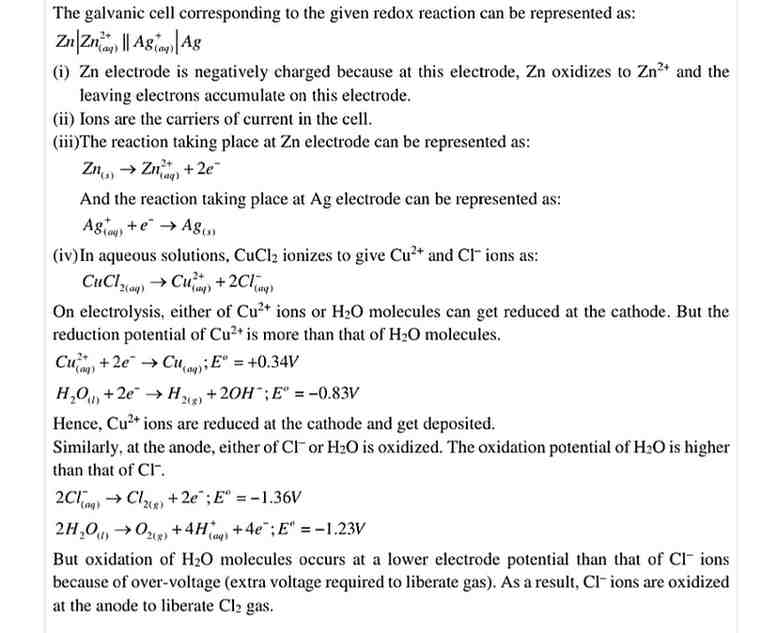
Conclusion of Ncert Solution of Redox Reactions
We have uploaded the solution of all the thirty questions of exercise. the answer of all the questions were written in simple and proper manner. we hope that this solution article will help you very much in your destination. if you have any doubts or confusion from this article please share in my comment section. we shall response properly and exactly.
At the last moment you are requested to share among your friends and relatives. Thanks for approaching this website.

